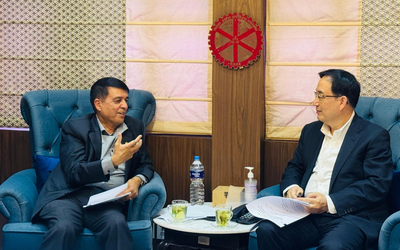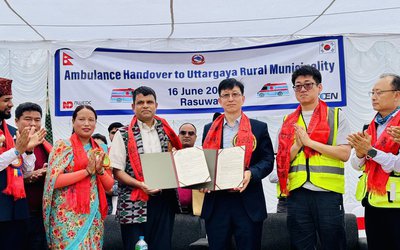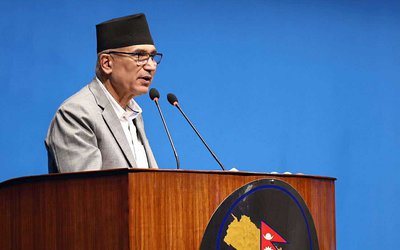More on Economy




US ambassador to Nepal Scott H. DeLisi might be making all the headlines as he is recently named as the new ambassador to Uganda by US president Barack Obama, and will soon leave the country, subject to confirmation by the United States Senate.
However, even after the decision by the US president, DeLisi is still continuing to improve relations between Nepal and the United States, and is making an effort for the betterment of the Nepalese people.
DeLisi recently spoke at the program ‘Last Thursdays’ organized by Entrepreneurs for Nepal and Samriddhi, and expressed his opinion about the development assistance by the United States to Nepal and the role that assistance is playing in fostering economic growth in Nepal.
The US ambassador stressed the role of private sector for the development of the country and kick starting the economy.
“Development may not create the jobs, but it is an essential precursor, a condition precedent, to building the enabling environment, developing the capacity, and nurturing the human resources that are essential to private sector-led economic growth,” said the US ambassador.
Economic growth has been Nepal’s greatest challenge for some time now and the country is lagging behind amid political instability and a lack of successful development policy to achieve it. “For some sixteen years this nation has been consumed, with first an insurgency, and then the post-insurgency political drama that still is ongoing. At the national level, despite progress and some degree of policy direction and leadership in various sectors, there is no coherent or broad vision of how political and social reform, development policy, and economic transformation tie together,” he said.
US Assistance to Nepal
United States has contributed much to Nepal for its development in the last six decades. “The reality is that our six decades of partnership with the Government of Nepal have not only been a pillar of our bilateral relationship, but our programs have, contributed significantly to Nepal’s socioeconomic development,” said DeLisi.
US assistance has a great role in eradicating Malaria in Terai. Likewise, as a result from the partnership with the US government, Nepal has decreased the death rate of mothers during or shortly after pregnancy by almost half between 1996 and 2006, and there has been similar achievement in reducing the death rate of children under five.
United States invested approximately $80 million (RS 6.4 billion) last via partnership with USAID. This assistance was targeted on key priority areas, including maternal and child health, agriculture, vocational education, anti-trafficking, and democracy and governance.
“We expect to make a similar financial commitment to Nepal’s development this year,” said the ambassador.
Although the contribution of Nepal for the global climate change is far less than half a percent, Nepal is still the 4th most-vulnerable country in the world to climate change. A $30 million USAID multi-year program in global climate change is being organized to reduce economic, environmental and humanitarian impact of the climate change along with the $ 6-8 million on Disaster Risk Reduction activities, according to the ambassador.
Similarly, United States is contributing in various other fields like agriculture, education, health etc. Some 70,000 young people have been trained under the Education for Income Generation (EIG) project, among them 84% of the graduates of its vocational education component are profitably employed, says the ambassador.
However, only the development assistance cannot do much good unless there are strong policies to back it up, along with a direction and a vision from the government. “We need the government to weigh the policy choices before it to ensure that development assistance can have a greater and more sustained impact on the nation’s future and on economic growth,” said DeLisi.
DeLisi also pointed out the current power crisis in the country and stated unless the power crisis is solved the US investments would be very difficult to lure. “Unless and until the government makes strategically considered policy choices to produce the energy that will fuel economic growth our efforts on the development front will not have the support they need to be broadly successful.”
Likewise, United States is also ready to build up on the already established development partnership, according to DeLisi. “The decision to bring the Peace Corps back to Nepal is important in itself and a clear signal of our ongoing commitment to bolster our already strong development partnership,” he said.
“We believe that our development assistance activities are an integral part of economic growth strategies for Nepal but, to be successful, we will all need to work together in defining and shaping the policy vision of the new Nepal.”
Meanwhile, the US ambassador believes that Nepal’s geographical location can be an asset rather than a liability and also stressed the need to get out of the sense of being a small island surrounded by two mighty oceans. “l was happy to hear Prime Minister Bhattarai recently recast Nepal’s position in the region as a bridge, leading to new destinations, rather than as the proverbial yam, waiting to get squashed between the two neighboring boulders.”






